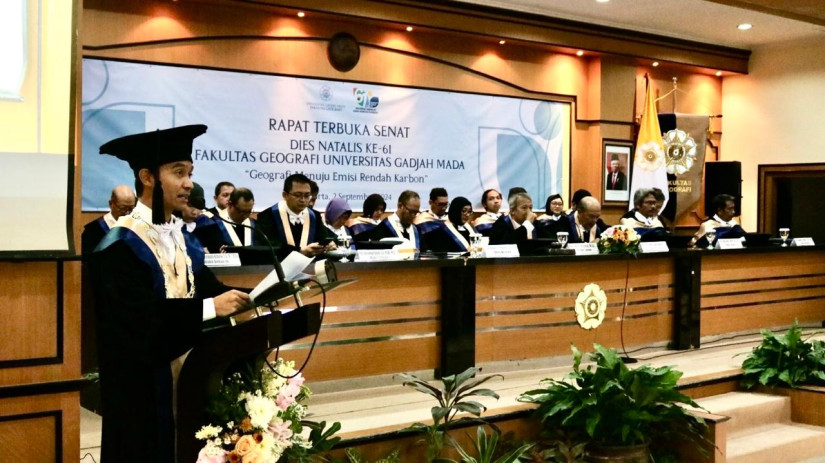
The UGM Faculty of Geography (Geography UGM) continues to promote research publications and establish international partnerships to enhance academic quality and build a global reputation.
The Dean of Geography UGM, Dr. Danang Sri Hadmoko, highlighted several achievements made by Geography UGM over the past few years. These include the number of research outputs and the citation count of faculty members, which exceeded target achievements.
“In terms of publications, in 2024, the number of multidisciplinary research outputs involving researchers from more than one faculty reached 82 titles, surpassing the targeted 18. The citation count for faculty members has also reached 860, exceeding the target of 492,” he revealed in his Dean’s Report at the 61st-anniversary celebration on Monday (Sep. 2) at the Merapi Auditorium of the Faculty of Geography.
The faculty also forged partnerships with various international entities to conduct joint research and projects. These include TH Köln University, Nagoya University, and the University of Tasmania.
He mentioned that Geography UGM continues to expand its global network in international collaboration to strengthen innovation and the implementation of the tri-dharma. In 2024, Geography UGM had 40 active international partnerships.
“These consist of 35 partnerships with universities and five with global partners spread across Europe, Asia, Australia, and America,” he explained.
At this year’s anniversary celebration, in addition to the Dean’s Report, a scientific lecture titled Low Carbon Emissions, a Sustainable Planet, and the Contribution of Geographic Modelling was delivered by UGM Geography lecturer Dr. Bowo Susilo.
In his lecture, Dr. Susilo discussed the urgency of carbon emissions, their impacts on human life, and the contributions that geographic modeling can provide in addressing these challenges.
“Greenhouse gas emissions, or carbon emissions, have become a major global concern since the late 20th century and continue to be so today,” he explained.
Dr. Susilo added that Indonesia, the sixth-largest carbon emitter in the world, has taken the right steps to reduce its emissions. However, further efforts are needed to continue reducing the country’s carbon output.
“In 2023, the rehabilitated forest area reached 550,000 hectares, exceeding the annual target of 500,000 hectares. This reforestation not only helps reduce carbon emissions but also enhances biodiversity and the quality of life for local communities who rely on forest resources,” he added.
According to him, geographic modeling plays a crucial role as a tool for finding solutions to reducing Indonesia’s carbon emissions. Geographic modeling can be utilized to explore various potential solutions to address these issues and support decision-making.
“Geographic modeling directly contributes to the spatial visualization of the intensity of resource utilization and human activities, which are affiliated with the levels of carbon absorption or emissions,” he explained.
Author: Hanif
Editor: Gusti Grehenson
Post-editor: Afif

